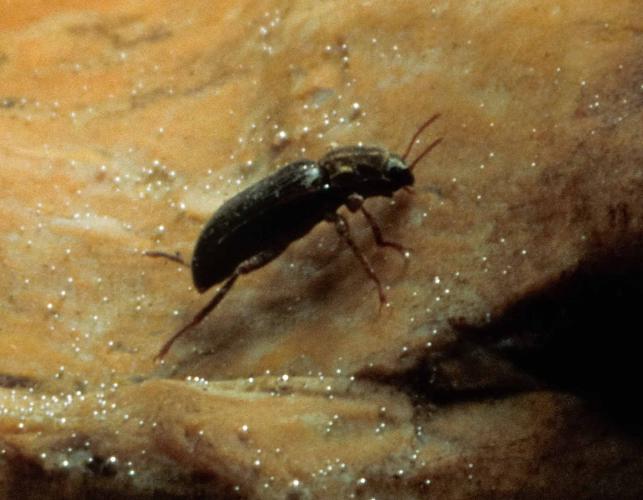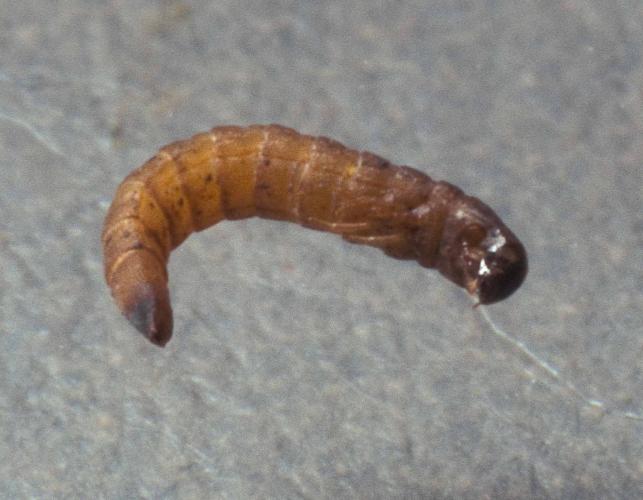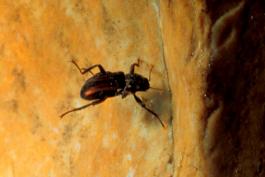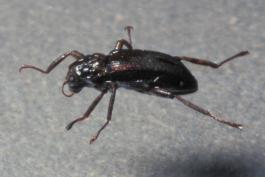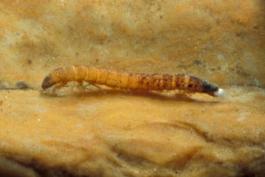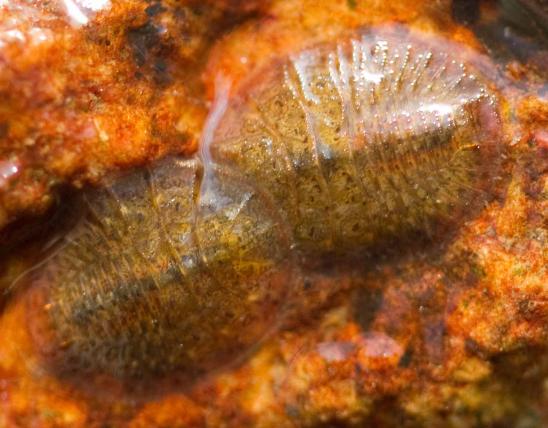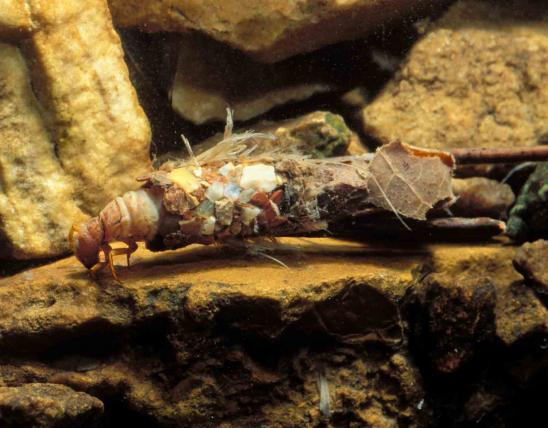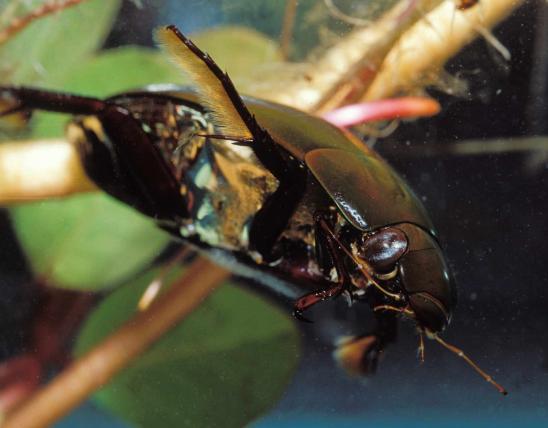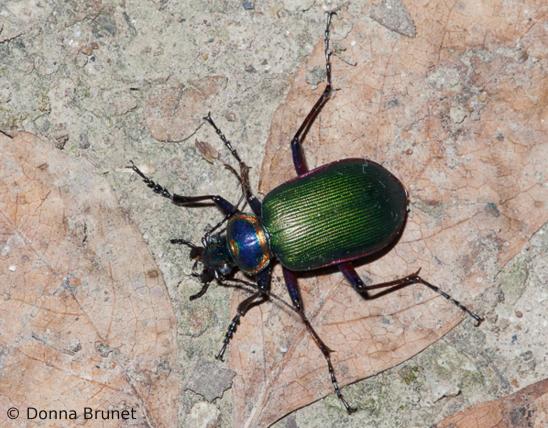
Adult riffle beetles are ant-sized, oval-bodied aquatic beetles with long legs that have clearly visible claws. The antennae are usually short, segmented, threadlike (lacking special tips) or slightly club-tipped (varying with species). Overall color is usually black, brown, or grayish; some species have two-toned, striped, banded, or mottled patterns, while others are plain. They typically live underwater, in swift-flowing streams, as both adults and larvae.
Habitat and behavior are helpful for identifying adult riffle beetles: they typically move slowly, crawling on submerged objects, and remain underwater. Unlike some other types of aquatic beetles, riffle beetles don’t swim around, and they do not swim at or just under the water surface.
Riffle beetle larvae are notably hard and stiff. The bodies are elongated, multi-segmented, usually tapering toward the hind end. Near the head, the thorax segments bear 3 pairs of legs, which are segmented, strong, and equipped with claws (1 claw per leg) to enable the animal to cling to objects in turbulent water. Color varies with species; usually brownish, yellowish, or blackish. Also, it can be hard to see, but the hind end of the larva has a pair of tiny hooks plus a clump of outward-pointing hairlike gills that can be retracted into the abdomen.
Similar species: Long-toed water beetles (family Dryopidae) are quite similar. The adults are usually aquatic, but the larvae live on land. The adults have short, club-shaped antennae whose segments (including any toothlike appendages that jut out perpendicularly) are wider than they are long. Usually they tuck their antennae out of sight, making them hard to see on these small animals.
Adult length: to about ⅜ inch (largest species); most other species are smaller, just a few millimeters, or about ⅛ inch long. Larvae may be up to about ½ inch long.
Statewide, in appropriate habitats. They are probably more commonly encountered in the Ozarks, since rocky, flowing Ozark streams generally fit their habitat requirements better.
Habitat and Conservation
Both adult and larval riffle beetles are notable for living in swift-flowing streams whose waters hold plentiful dissolved oxygen and whose streambeds are rocky and contain fallen leaves. The beetles use their long legs with well-developed claws to cling and crawl on rocks, submerged logs, and other objects.
In a few species, the adults may live out of water on the land, but those are the exceptions. Also, some species may occur in the calmer waters of ponds and lakes, but the ones that live in flowing-water habitats are the most numerous and typical.
Being fully aquatic, riffle beetles (adults and larvae) can stay underwater for extended periods or even indefinitely. The larvae obtain oxygen via the hairlike gills at the abdomen tip, while the adults breathe through a process called plastron respiration. In this process, a thin film of air (called a plastron) is trapped in hairs on the body surface, and the plastron functions like a gill. This sheet of air is in contact with an air space beneath the elytra (shell-like modified forewings), where the openings to the insect’s respiratory organs are located. As the insect consumes oxygen, the reservoir of the plastron is replenished by diffusion of more dissolved oxygen from the water. This system won’t work, however, unless there is plenty of dissolved oxygen in the surrounding water. This is one reason why riffle beetles are mostly restricted to shallow, cool, flowing, well-aerated streams.
The presence or absence of riffle beetles can tell us about a stream’s water quality, particularly regarding the amount of dissolved oxygen in the water and presence of water pollutants or too much silt (loose dirt flowing into the stream after rains, typically coating the bottom). Riffle beetles tend to decrease or disappear when a stream habitat is damaged by runoff pollution and an accumulation of silt generated by human agriculture, construction, industrial, and other activities.
Food
Larvae and adult riffle beetles scrape the surfaces of submerged leaves, rocks, roots, logs, and other objects. They eat decaying vegetation, algae, and detritus.
Life Cycle
Riffle beetles, like other beetles, undergo complete metamorphosis, which means that their immature (larval) stages look quite different from the adult, sexually mature stage. Adults mate and lay eggs; the eggs hatch into tiny grublike or wormlike larvae; and the larvae eat and grow, molting as they get larger. Depending on species, there may be 5–8 larval molts. The larval stage ends with the pupa, which is an inactive stage wherein the insect transforms into an adult. The mature larvae build pupal chambers in the mud or sand along stream edges. Pupation lasts about 2 weeks. Some species of riffle beetles complete their life cycle in the course of a single season, but some can live for three or even five years.
Riffle beetles may be active at any time of the year.
Human Connections
Riffle beetles require flowing water with a high dissolved oxygen content and lack of siltation. This makes them an excellent indicator of water quality, thus useful to people. This is especially the case for Missouri Ozark streams, which are typically rocky, clear, fast-flowing, high-oxygen environments. Riffle beetles are also sensitive to pollutants and to environmental changes in general. Water resource scientists collect invertebrates from streams and use the presence or absence of certain types of organisms as a gauge for how healthy the streams are. When plenty of riffle beetles are collected, it is taken as a sign that a stream is healthy.
Researchers who use riffle beetles in stream-health surveys consider collections of adult riffle beetles stronger evidence of water quality than when larval riffle beetles are found. Why? Because adult riffle beetles had to survive long enough in the stream to have become adults, while larval beetles, being younger, cannot indicate water quality for as long a period.
Start or join a Stream Team at mostreamteam.org.
Ecosystem Connections
Riffle beetles are detritivores, eating mostly dead or decaying organic materials. In turn, they are eaten by a variety of insect-eating aquatic animals, including fish.
Riffle beetles are well named. What’s a riffle? It’s a shallow section of a stream where bedrock or other rocks are near the surface, causing the water to flow through fast and rough — a small-scale rapids. Many Ozark streams consist of a series of short pools connected by well-defined riffles. Stream-dwelling animals often live in specific parts of the stream. Some prefer the quieter waters of the pools, some live along the stream edge, while others stick to the riffles. Most riffle-dwellers have special adaptations to help them cling to the rocks amid the turbulent waters. In addition to riffle beetles, other animals that share this special, splashy subhabitat are darters, sculpins, crayfishes, hellgrammites, caddisfly larvae, mayfly larvae, stonefly larvae, and the coin-shaped larvae of water penny beetles.
Riffle beetles are closely connected to certain stream conditions, especially dissolved oxygen (DO) levels. Many things can influence how much oxygen water can hold. For example, cooler water, such as in cold, spring-fed streams, can hold more DO than warmer water. Water turbulence at the surface brings more water in contact with air, allowing more oxygen to get into moving water than in still, stagnant water. Bacteria, which are present when something in the water has died and is decaying, consume oxygen from the water, making it unavailable for other species. A boom-and-bust cycle of organisms such as algae (fed by fertilizer runoff) or Asian clams (which can multiply rapidly, then have a mass die-off at the first dry spell) can cause wide fluctuations in the amount of dissolved oxygen in a body of water. This is why the presence of adult riffle beetles, possibly three years old, show a long-term stability of DO levels.
